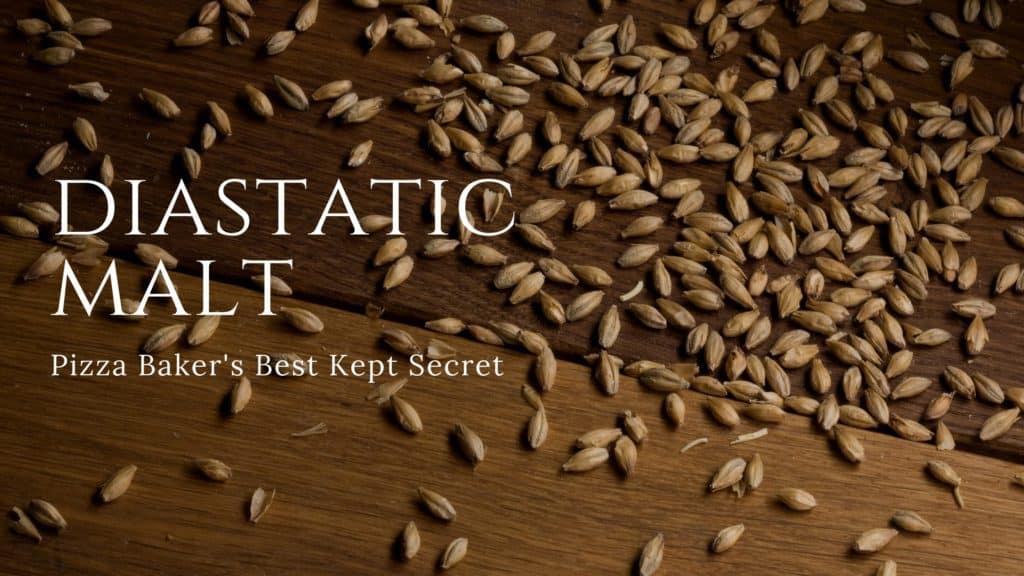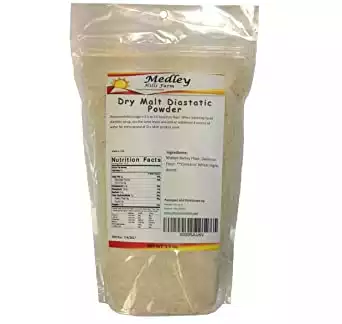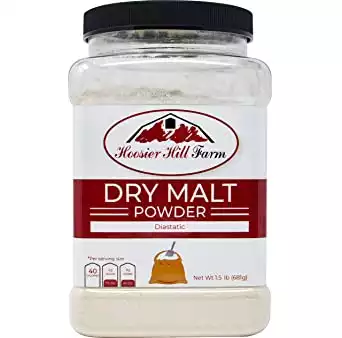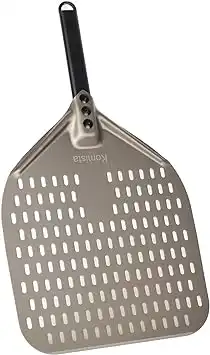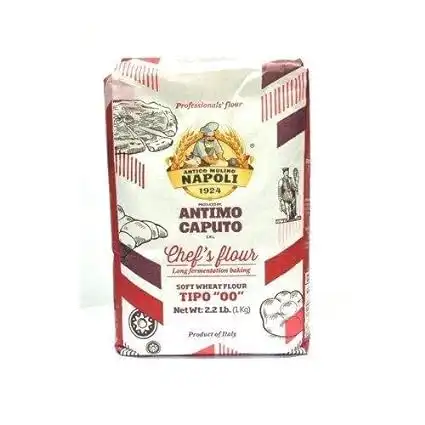If you’ve been searching for that secret ingredient to elevate your pizza dough, look no further.
In this post, we’ll unravel the mysteries of diastatic malt powder, covering everything from its creation to its uses, and even its distinction from non-diastatic malt powder.
So, are you ready to take your pizza dough game to the next level?
Keep reading to discover the wonders of diastatic malt powder and how it can transform your baking experience!
Let’s get started!
Here’s What You Will Find:
Key Takeaways
Diastatic Malt Powder in Pizza Dough
Diastatic malt powder is a free-flowing powder with a combination of sweetness and enzyme activity that gives a better structure, increased volume, and a pleasing golden-brown color and improved taste to the pizza crust.
For pizza dough, use ½ teaspoon to 1 teaspoon per 3 cups of flour or 2% of the total weight of your pizza flour when using the baker’s percentage method. Add it to the dry ingredients, not olive oil or the water-yeast mixture.
On average, diastatic malt will last about a year.
What is Diastatic Malt Powder?
Diastatic malt powder is a natural, enzyme-rich ingredient made from sprouted grains, typically barley, that has been dried and ground into a fine powder. The sprouting process activates enzymes, such as amylase, which are responsible for breaking down starches into simpler sugars. This enzymatic activity plays a crucial role in fermentation, making diastatic malt powder a popular addition to bread, pizza dough, and other baked goods.
Diastatic malt powder is a free-flowing powder with a combination of sweetness and enzyme activity that gives pizza dough a pleasing golden-brown crust color.
When added to the dough, diastatic malt powder enhances fermentation by providing a readily available source of sugars for the yeast to feed on. This results in improved dough rise, better crust browning, and a more tender, flavorful crumb.
In addition, the enzymes in diastatic malt powder can help break down complex carbohydrates, making them easier to digest and enhancing the overall nutritional value of the final product.
Diastatic Malt Powder in Pizza Dough
Diastatic malt powder’s unique properties make it a game-changer for pizza dough enthusiasts looking to achieve a perfectly risen and flavorful crust. The enzymes in diastatic malt powder break down the starches in the dough into simpler sugars, providing a feast for the yeast and enhancing fermentation.
This results in a more robust rise, which contributes to an airy, tender, and evenly baked crust. Additionally, the malt powder’s subtle sweetness improves the overall taste, while the sugars produced by its enzymatic action promote better browning and caramelization, creating that sought-after, crispy exterior.
By incorporating diastatic malt powder into your pizza dough recipe, you’ll elevate your homemade pies to a professional level, impressing friends and family with your masterful crusts and mouthwatering flavors.
Benefits of Using Diastatic Malt Powder in Pizza Dough
Using diastatic malt powder in pizza dough offers several benefits that can elevate your homemade pizzas to new heights:
Improved rise
Diastatic malt powder provides an accessible source of sugars for yeast, promoting a more vigorous fermentation process. This results in a better rise, giving your pizza dough a light and airy texture.
Enhanced crust browning
The sugars produced by the enzymatic action of diastatic malt powder contribute to the Maillard reaction, which is responsible for the browning and caramelization of the crust. This creates a beautifully golden, crispy exterior that’s desirable in a perfect pizza crust.
Tender crumb
The enzymes in diastatic malt powder help break down complex carbohydrates, resulting in a softer, more tender crumb in the baked pizza crust.
Improved flavor
The subtle sweetness imparted by diastatic malt powder enhances the overall taste of the pizza dough, adding a pleasant hint of maltiness.
Extended freshness
The enzymatic action of diastatic malt powder can help retain moisture in the baked crust, prolonging its freshness and keeping it from becoming stale too quickly.
Enhanced digestibility
The enzymes in diastatic malt powder break down complex carbohydrates, making the final product easier to digest and increasing the bioavailability of some nutrients.
Incorporating diastatic malt powder into your pizza dough recipe can significantly improve the texture, appearance, flavor, and digestibility of your homemade pizzas, making them a hit with friends and family.
Diastatic Malt Powder vs. Non-Diastatic Malt Powder
The term “diastatic” refers to the presence or absence of diastase, a group of enzymes such as alpha-amylase and beta-amylase that are useful in baking for their role in the fermentation process.
For this reason, diastatic malt is sometimes called “enzyme-active.”
Enzymatic content is measured in Degrees Lintner.
Malt Grain
The term “malt” refers to cereal grain that has been “malted.” If the type of grain in question isn’t specified, it’ll likely be barley malt, but you can use other cereal grains. Each different kind of grain offers its distinct characteristics.
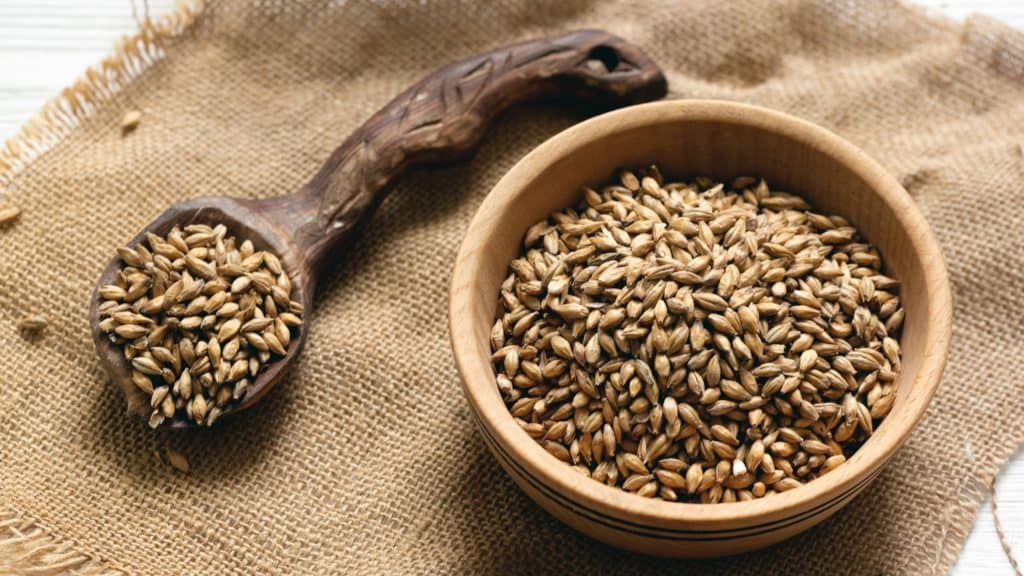
To better understand the difference between diastatic and non-diastatic malt, it helps first to be familiar with the concepts of germination and fermentation and the malting process itself.
Although fermentation is used in baking, it also occurs naturally in the wild.
Every seed naturally contains a supply of nutrients that it will use to nourish itself as it grows into a new plant; in a process known as germination, the seed sprouts when it senses that conditions are right outside for it to grow and survive.
When this happens, enzymes that are also present begin to break down and store carbohydrates into more readily usable sugars in a process known as fermentation.
After fermentation and the seeds have sprouted, the sugar produced from these carbohydrates is broken down further by yeast cells, releasing carbon dioxide into their surroundings.
The presence of carbon dioxide in your pizza dough balls helps them to rise and makes the dough easier to handle.
The Malting Process
The term “diastase” is derived from the Greek word “diastasis,” meaning “a parting or separation.” This original meaning refers to separating soluble sugars from the rest of the plant material being used.
Malting Process
In the first stage of the malting process, the cereal grain is dried and stored until it is ready to germinate. Many seeds will not germinate immediately, so this initial drying usually takes around six weeks. At this point, the seeds are no longer dormant, and the next stage can begin.
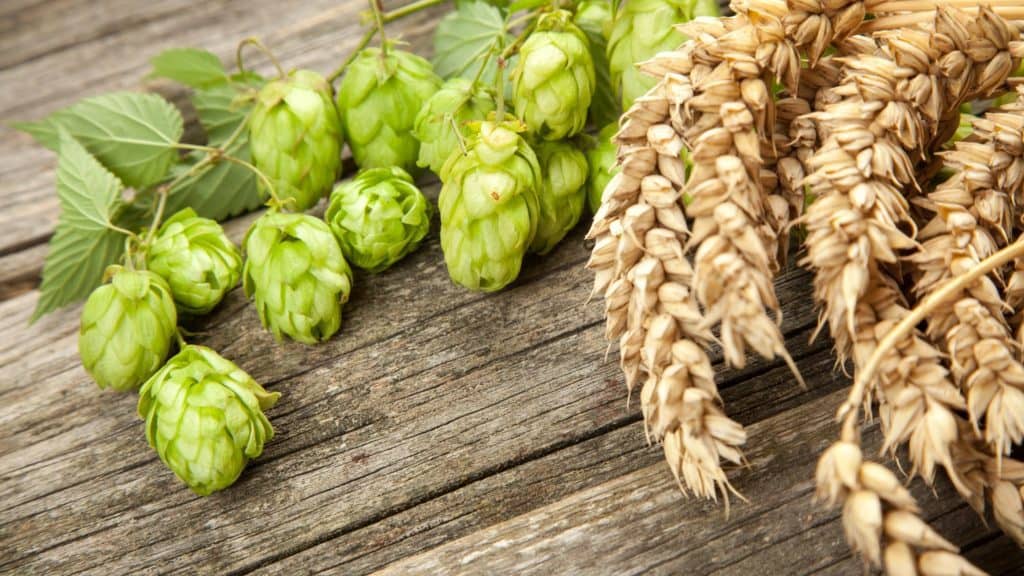
Germination Process
The grain is soaked in water for several days until it begins to sprout. The germination process is then quickly brought to a halt.
The temperature at which it is halted determines whether the finished malt will be diastatic or non-diastatic.
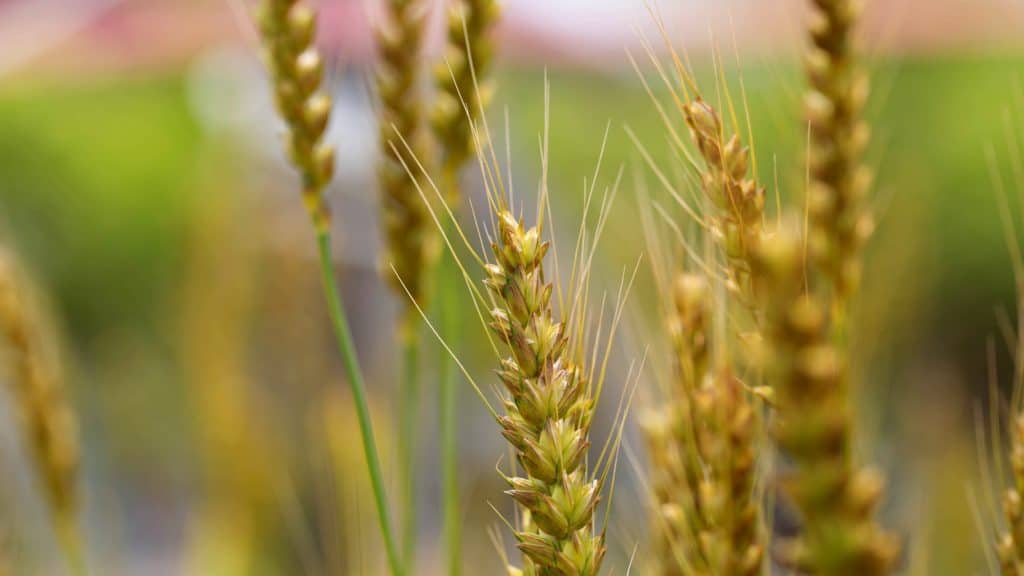
Diastatic Malt Processing Temperature
Non-Diastatic Malt
By contrast, non-diastatic malt has had its germination process stopped by heating it at a much higher temperature.
Unfortunately, the heat used in this method destroys those precious enzymes.
Since fewer enzymes are present in non-diastatic malt, less sugar is produced via fermentation since the yeast has less to consume, less carbon dioxide, and less rise.
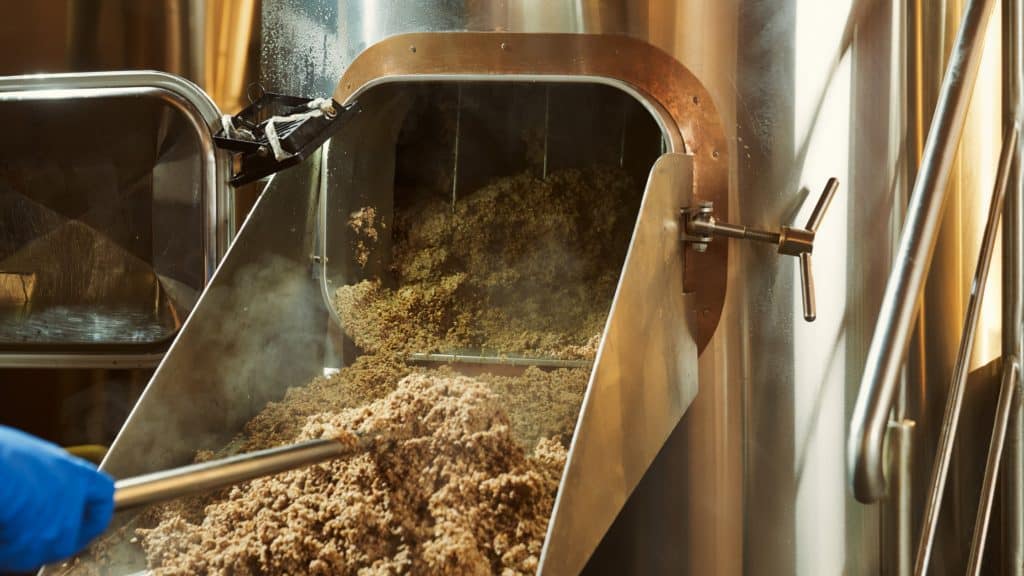
When you add dry diastatic malt powder to your baking recipe, more starches are broken down into sugars, which yeasts may consume as food during the long pizza dough process, resulting in a higher rise.
This extra sugar also aids in caramelizing a golden-brown crust, which would otherwise be absent in a slow-processed pizza dough.
Diastatic Malt Powder

Diastatic malt also promotes browning and improves the flavor and texture of your crust.
After it’s dried or heated, the malt is ground into malt powder. Do be aware that some high-protein flour or bread flour already has malt powder added to it.
If you’re unsure whether there’s any malt in the flour already, there probably isn’t, but you should be able to tell by the time you’re done mixing the pizza dough.
What is the Difference Between Diastatic vs. Non-Diastatic Malt Powder?
Diastatic and non-diastatic malt powders differ in their enzyme content and their primary functions in baking.
Diastatic malt powder:
As mentioned earlier, diastatic malt powder is made from sprouted grains that have been dried and ground, preserving the active enzymes within. The most notable enzyme is amylase, which breaks down starches into simpler sugars. This enzymatic activity contributes to fermentation, improved rise, and enhanced texture in baked goods. Diastatic malt powder is typically used in bread, pizza dough, and other yeast-leavened products for its dough-enhancing properties.
Non-diastatic malt powder:
On the other hand, non-diastatic malt powder is made from grains that have been sprouted, dried, and roasted at higher temperatures, which inactivates the enzymes. This type of malt powder does not have the same enzymatic properties as diastatic malt powder, but it does provide a rich, malty flavor and color to baked goods. Non-diastatic malt powder is often used as a sweetener or flavor enhancer in products like cookies, bagels, and malted milk beverages.
The primary difference between diastatic and non-diastatic malt powders is their enzyme content and function in baking. Diastatic malt powder is used for its enzymatic activity, which improves fermentation and dough characteristics, while non-diastatic malt powder is mainly used for its flavor and color-enhancing properties.
How Much Diastatic Malt Powder You Should Use for Pizza
We recommend using 1/2 to 1 teaspoon per 3 cups of flour or 2% Diastatic Malt for the total flour weight of pizza dough.
To mix diastatic malt powder into your pizza dough, add it directly to the flour in a large bowl using a wooden spoon or the dough whisk of a stand mixer. You may also use a food processor. Please do not mix diastatic malt with olive oil or wet ingredients, as it will not mix well.
For example, if you use 500g of flour, you would have to add 10g of Diastatic Malt. In short, weigh your flour and multiply the result by .02. If you don’t have a scale, use 1/2 to 1 teaspoon per 3 cups of flour.
Enzyme-Active Diastatic Malt Powder
When making pizza, you’ll want to use an enzyme-active diastatic malt powder weighing about 0.25 to 5% of the total weight of your pizza flour.
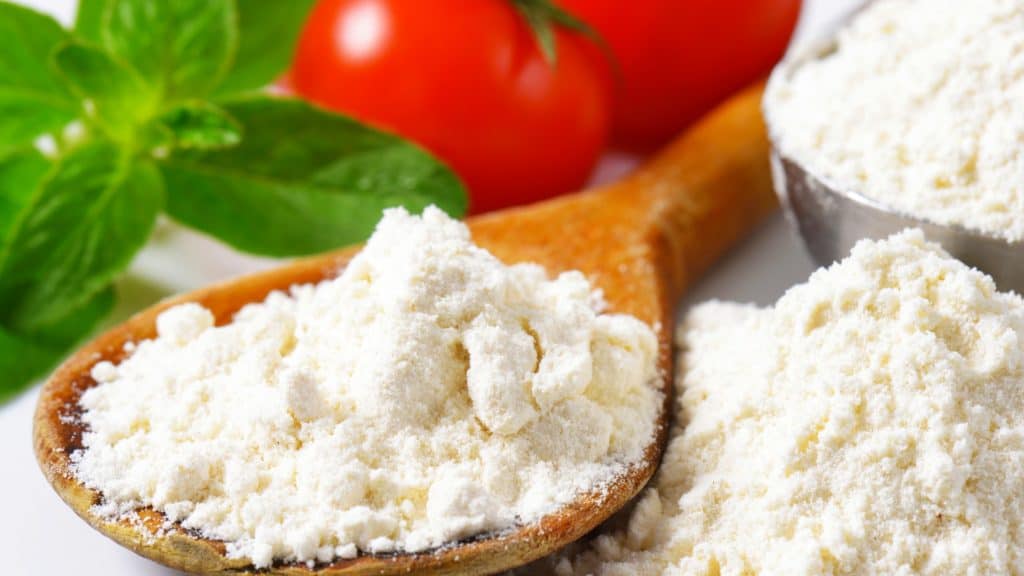
Make sure you add it to the dry ingredients instead of mixing them with your yeast and water.
Diastatic Malt and Baker’s Percentage Method (Hydration)
An important consideration when you weigh your ingredients and use diastatic malt. The malt will add to the total weight of the flour.
To keep the pizza dough’s hydration at your desired level, you need to account for the malt you added to the flour.
For example, our base recipe calls for 500g of pizza or bread flour at 65% hydration or 325g of water. But if you add 10g of malt to the mix, you now have 510g of total flour weight.
So, to calculate the hydration, you must multiply your hydration factor by the total weight of the flour.
In this case, 510 x .65 = 332 g of water.
Is it going to make a difference? Most certainly!
That can make the difference between having a dry or a moist crust.
If you don’t want to go through the trouble of weighing your ingredients, you can use ½ teaspoon to 1 teaspoon per 3 cups of flour.
Pizza Pun
Why are pizza-baking recipes so secretive?
They’re on a knead-the-dough basis.
Diastatic Malt Powder in Pizza
With so many pizza styles to choose from, you may be wondering about the best kind to choose when using diastatic malt in pizza making.
We prefer diastatic malt powder with Chicago-style deep-dish pizza or any variants.
Also, it gives exceptionally sound results when making a dessert pizza. With more rise in your dough, your pizza will be better able to hold all those delicious layers of meat, whole milk mozzarella, sauce, and veggies!
Warning Using Non-Diastatic Malt
It’s essential to use diastatic malt powder for pizza because non-diastatic malt is just another sugar form.
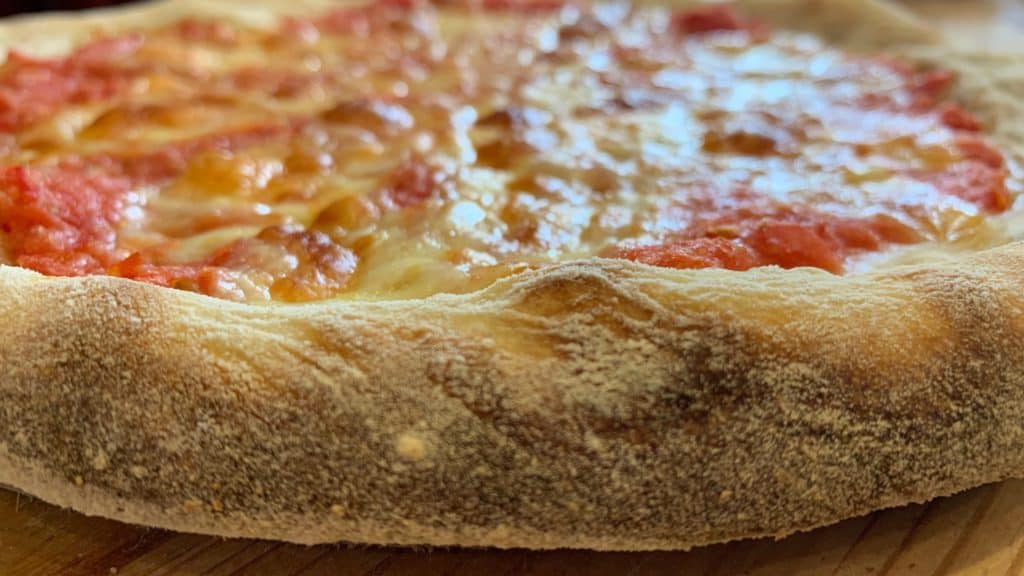
Also, non-diastatic malt can turn your crust reddish or give it a flavor like candy, a taste like malted milk balls. And while malted milk balls are good on their own, they’re probably now what you’re looking for unless you’re making a dessert pizza.

Pro Tip
When using diastatic malt, a little can do a lot. You don’t need a huge amount of malt to add that nutty flavor to a recipe. More often than not, a little goes a long way, especially when using liquid malt.
How Long Does Diastatic Malt Powder Last?
On average diastatic malt will last about a year. Of course, it is always best to check the expiration date on the package. However, a well-sealed container in the refrigerator can be used past its “best by” date.
Where to Find Diastatic Malt Powder
Diastatic malt is readily available in bakery supplies stores and health food stores, or you can get it online. Here are our favorites which you can get on Amazon.
Do You Want to Try Non-Diastatic Malt Powder?
If you are interested in trying out non-diastatic malt powder to see if you find any difference in your baking, here is what we recommend.
This free-flowing diastatic powder was specially formulated to provide an economical combination of enzymatic activity, sweetness, and appealing crust color to baked goods. Adding our Dry Malt Powder to your baking recipe allows more starches to be broken down into sugars, which yeasts can then use as food during a prolonged dough process, resulting in an enhanced rise.
A free-flowing diastatic powder, old fashion dry malt powder is formulated to provide an economical combination of enzymatic activity, sweetness, and appealing crust color to baked goods. Great for bread, rolls, buns, crackers, sweet dough, cakes, cookies, and all products which require a true natural malt flavor.
How to Store Diastatic Malt Powder
Now that you know how to use diastatic malt powder in baking, let’s consider other considerations.
You’ll want to be sure to store your diastatic malt powder at temperatures below 90 degrees Fahrenheit.
If possible, you’ll want to refrigerate it since the enzymes can go bad after a while. It should have an expiration date, but its shelf life is generally comparable to bread flour.
If necessary, you can freeze diastatic malt powder, which will work just as well once it has been thawed.
However, it is hygroscopic (meaning it retains moisture well), so if you’ve got a large bag of it, you can freeze it with no problem.
Diastatic Malt Powder Products and Substitutes
If you cannot find any diastatic malt powder in stores in your area, you could try using diastatic malt syrup instead.
This product might also be referred to as diastatic malt extract. It’s a liquid instead of a powder, and not all diastatic malt enzymes are present in diastatic malt extract, but the most thermostable ones are.
Luckily, it’s those thermostable enzymes that are the most important.
Alternatively, you could try ordering some diastatic malt from our link below.
Here is what the PROs at Homemade Pizza Pro Use and Recommend
A free-flowing diastatic powder, old fashion dry malt powder is formulated to provide an economical combination of enzymatic activity, sweetness, and appealing crust color to baked goods. Great for bread, rolls, buns, crackers, sweet dough, cakes, cookies, and all products which require a true natural malt flavor.
Additional Resources on Dough Enhancers
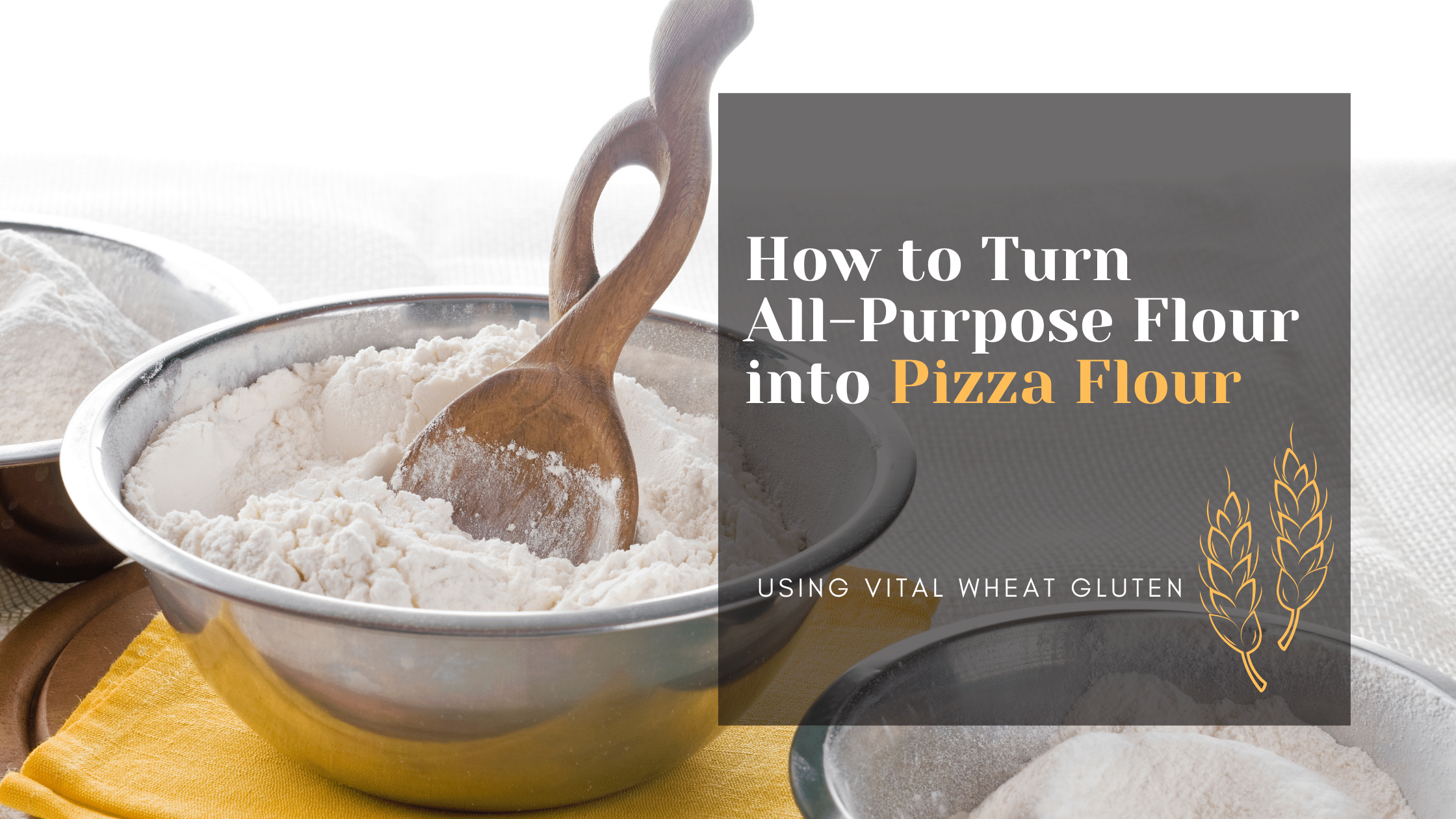
How to Instantly Turn All-Purpose Flour into Pizza Flour
the PROs
How to Turn All-Purpose Flour into Pizza Flour If you want to know how to turn all-purpose flour into pizza …

Unleash the Flavor: How to Use Oil in Pizza Dough
the PROs
This guide will dive a bit deeper into why oil will affect your pizza dough and how it can also enhance your pizza’s other attributes. Hopefully, you will be able to take advantage of these tips on oil on pizza dough in the end. So, let’s dive in.

Vital Wheat Gluten: The Magic Touch for Pizza Dough
the PROs
Is your homemade pizza dough missing something? Maybe it’s not rising enough, or it’s not holding its shape as you’d like it to, or it’s just too crumbly. Perhaps you want it to be softer on the inside or crispier on the outside, or you wish it were higher in protein. Don’t worry! All these factors and more can be addressed by adding extra gluten to your recipe. Here’s our guide to everything you need to know for using vital wheat gluten in pizza dough! So let’s get started!
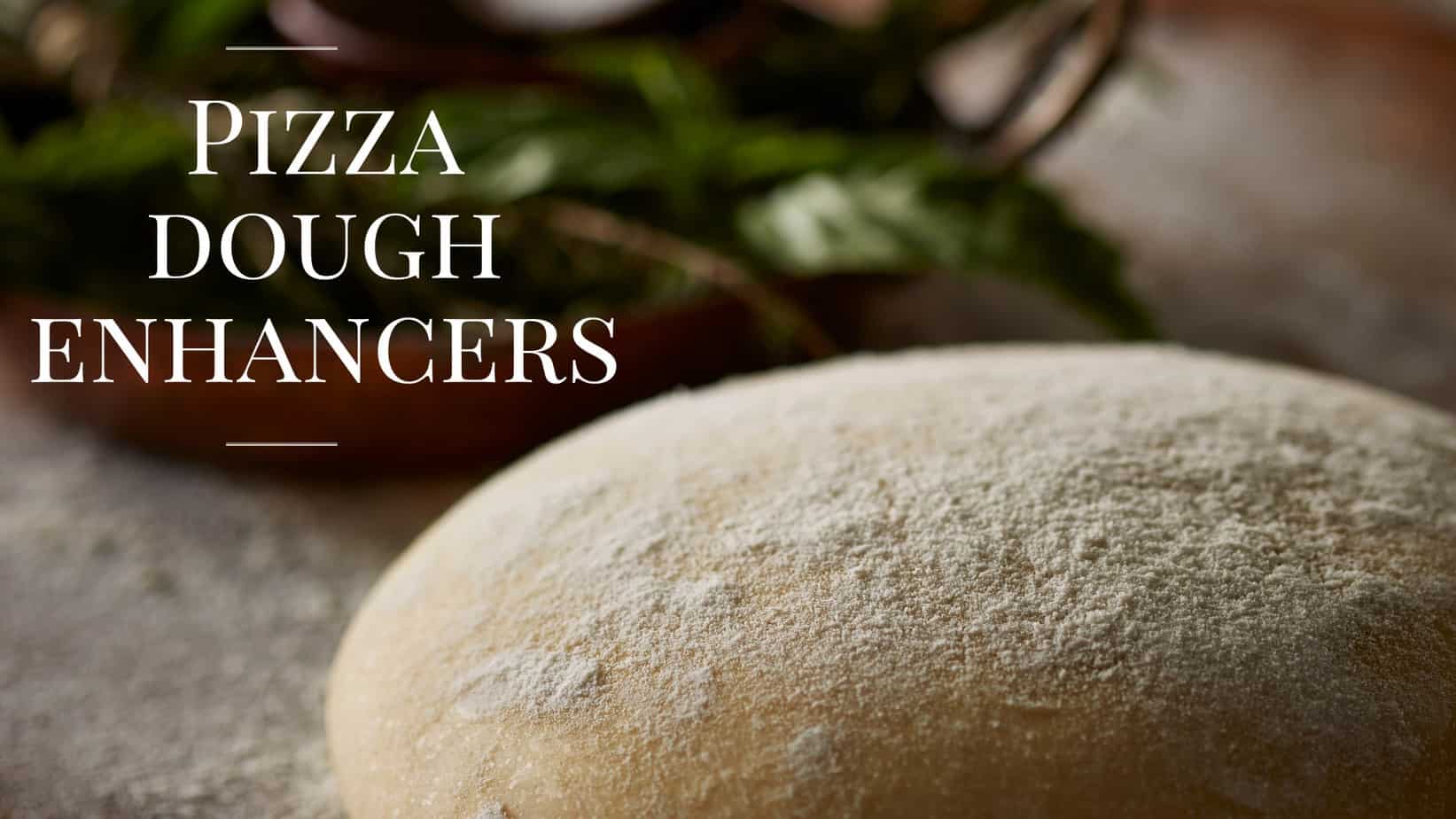
Pizza Dough Enhancers: Boost Your Pizza Dough Flavor!
the PROs
Are you eager to learn how to make pizza dough taste better? In this article, we will show you what you can do to improve the flavor and the structure of your pizza dough.
The Last Slice
We hope this has been an informative experience for you. With this, you should better understand diastatic malt powder and how it can be used in your next pizza-baking endeavor.
There are many factors to consider, but practice is the best way to improve your pizza-baking skills.
Knowledge of the ingredients you use and the chemical processes that occur throughout the process is always helpful, even necessary sometimes.
Still, nothing will ultimately replace doing the thing and seeing the results yourself.
And don’t forget to be creative and have fun with it!
Baking pizza may be a science, but it’s also an art.
Ultimately, you should follow your vision and see where it leads you. You may be surprised by how well it turns out.
Thank you for spending your time here with us today.
We’d love to know more about your techniques. What kind of pizza have you made lately, and how did it turn out?
Did you use any unusual ingredients or try anything new?
Let us know in the comments down below!
When in Doubt, Check Our Resources
To help you become a better homemade pizza baker, we developed these reference sources you can use when making any of our recipes.
Check Amazon’s Pizza-Making Must-Haves
Why have two pizza peels when you can only have one. This pizza peel surpasses the benefits of wood peels with the convenience of a metal peel. It's made entirely from anodized aluminum for a lightweight design that's incredibly durable, too. It's designed to be used frequently in high-heat pizza ovens.
The Etekcity Lasergrip 800 Digital Infrared Thermometer is a versatile and reliable tool for accurate temperature measurements. Its non-contact design allows you to measure temperatures from a distance, making it safe and hygienic for various applications. With a wide temperature range of -58°F to 1382°F (-50°C to 750°C), this infrared thermometer is perfect for both everyday cooking needs and professional uses.
The built-in laser pointer helps you target the specific area you want to measure, ensuring precision and consistency. Whether you're grilling, cooking, or performing household maintenance, the Etekcity Lasergrip 800 provides fast and accurate temperature readings with ease.
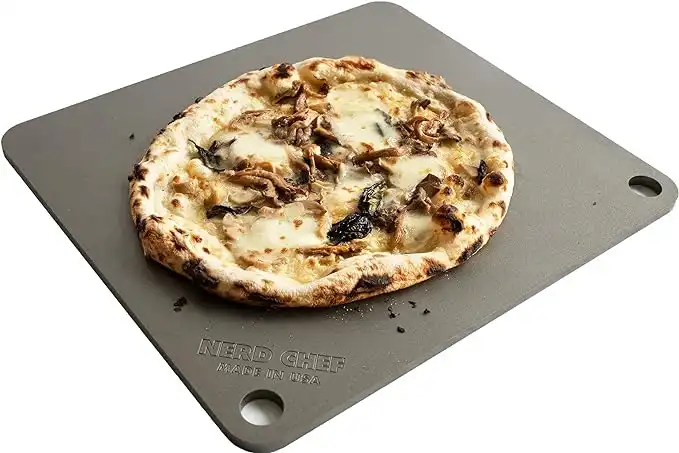 NerdChef Steel Stone
NerdChef Steel Stone
Making great crusts traditionally requires a 700-1000F wood-fired oven. Nerdchef Steel Stone replicates that performance in a home oven with its super-high heat transfer ability - transferring heat energy 20 times faster than ceramic. It creates beautiful and crispier crusts, gorgeous blistering throughout, and it cooks faster.
The Chef's flour is a general-purpose, high gluten flour that works well for many recipes. "Tipo 00" refers to how refined the flour is. Chef's Flour is best for those who want to bake in their traditional home oven up to 500 degrees Fahrenheit!
Enjoy!
Not a PRO? Not a Problem!
Take a pizza class to bring your pizza skills to the next level,
so you can be a PRO!
Related Posts

Costco Pizza Delivery: Find How You Can Get It Now!
the PROs
People go to Costco’s food court for many different reasons, but the cheesy slice of pizza they serve is among …
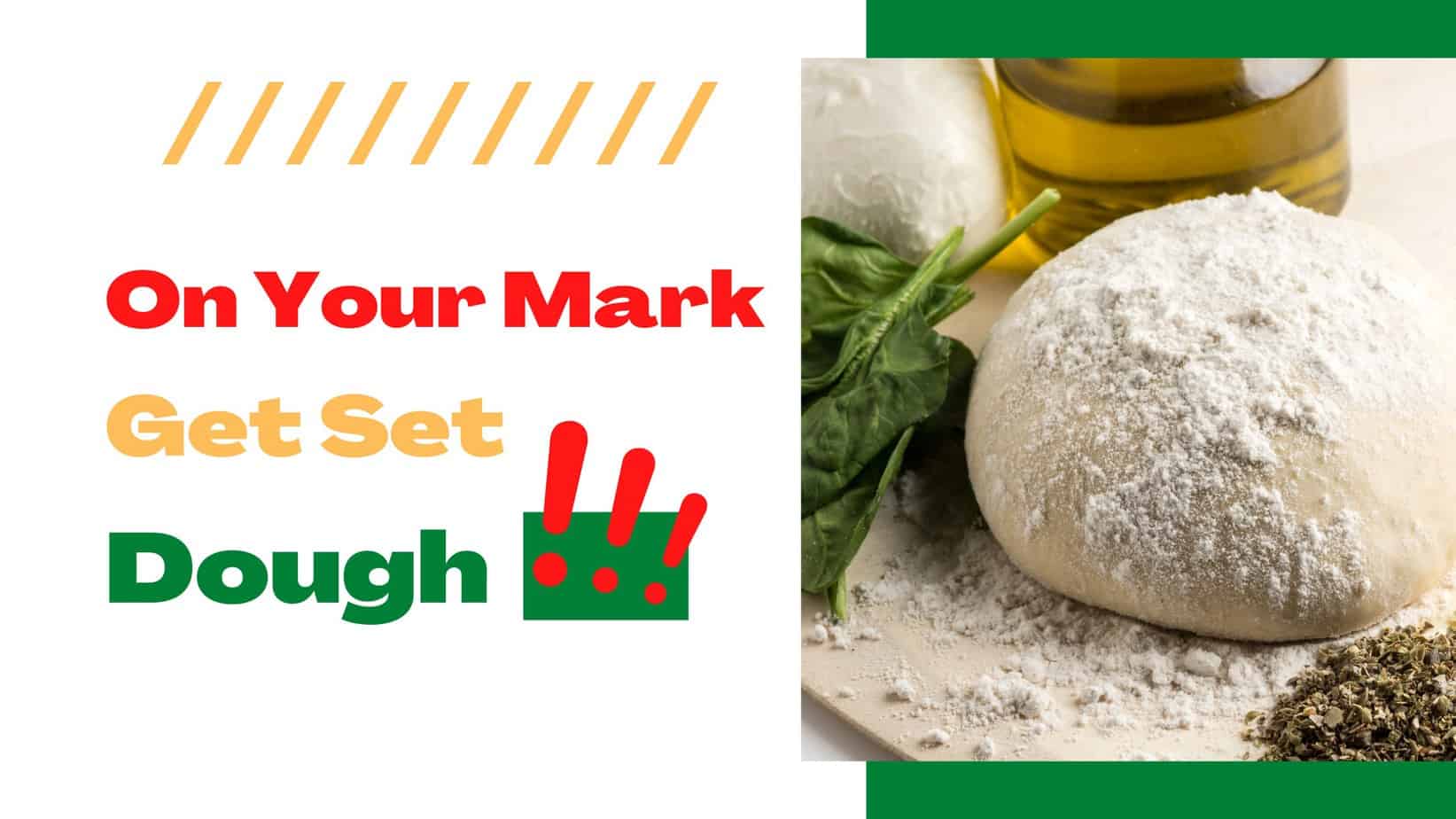
Pizza for Beginners: Don’t Buy Pizza, Make It! Here’s How to Get Started!
the PROs
You have this idea that you want to make pizza at home as opposed to ordering it, but where do you start? Don’t worry! Here you will find answers and directions to all your questions.

Pizza Toppings Under Cheese or Over Cheese? [Why the Order Matters]
the PROs
Is Pizza Cheese on Top or Bottom? Hey pizza lovers, are you wondering if you should layer pizza toppings under …
Newsletter
Subscribe to our Recipe of the Week newsletter and receive our partners’ latest recipes, tips, and discount offers.
Keep in Touch!
